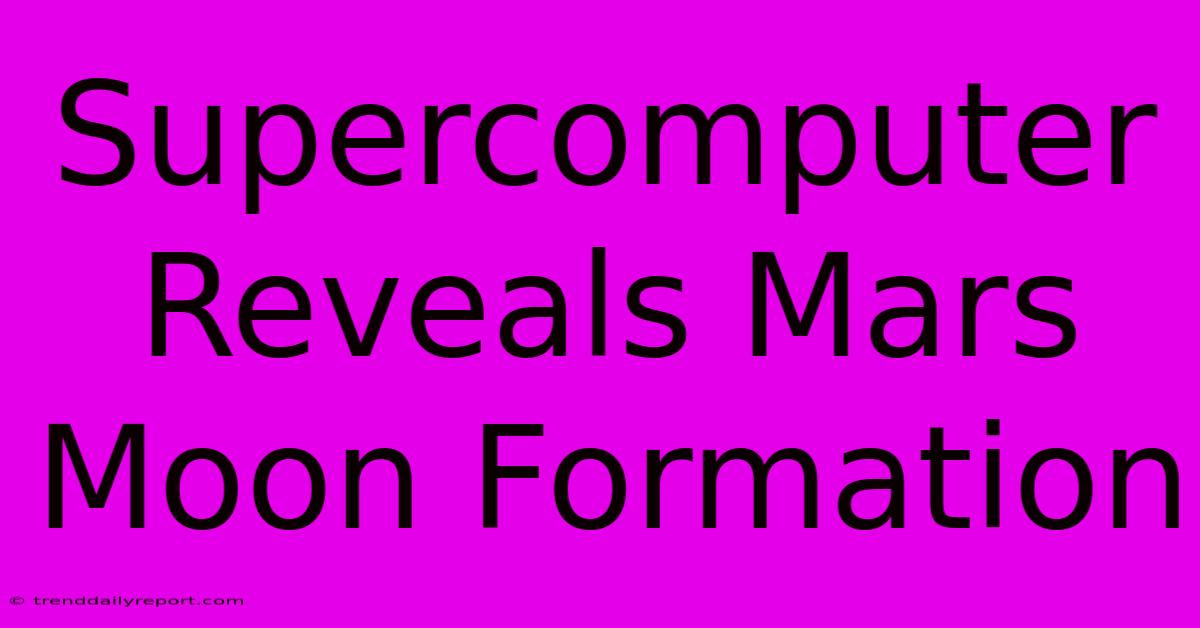Supercomputer Reveals Mars Moon Formation

Discover more detailed and exciting information on our website. Click the link below to start your adventure: Visit Best Website Supercomputer Reveals Mars Moon Formation. Don't miss out!
Table of Contents
Supercomputer Reveals Mars' Moon Formation: A Deep Dive into Phobos and Deimos' Origins
Hey everyone! So, you know how I'm obsessed with space? Well, buckle up, because this blew my mind. I was reading about this crazy new supercomputer simulation that's totally changed our understanding of how Mars got its moons, Phobos and Deimos. It's wild stuff, and I'm gonna try and break it down for you.
The Mystery of Mars' Moons
For years, scientists have been scratching their heads over these two little potatoes orbiting the red planet. They're tiny – way smaller than our moon – and weirdly shaped. They don't look like they formed the same way as most moons. I mean, the prevailing theory was they were captured asteroids, right? But that theory always felt a little… lacking. Like, it didn't fully explain everything.
My initial thought, like a lot of people I'm sure, was "Asteroids? Duh, that's it!" But there were inconsistencies. The orbits are surprisingly circular, which is unusual for captured objects. Think about it: if an asteroid just got snagged by Mars' gravity, you'd expect a more elliptical, chaotic orbit, wouldn't ya?
That’s where the supercomputer comes in.
The Simulation: A Giant Leap for Mars-Moon Science
This supercomputer simulation, using the most advanced modeling techniques, basically ran a billion (okay, maybe a few hundred million) different scenarios of Mars' early history. They ran all these simulations to see which ones matched up best with the current size, shape and orbits of Phobos and Deimos.
It was a seriously massive undertaking – seriously impressive. The results? Mind-blowing, to say the least. It looks like Phobos and Deimos weren't captured asteroids at all! The simulation showed a much more dramatic process: a giant impact that launched debris into orbit around Mars, eventually forming the two moons we see today.
Remember that movie, Armageddon? Think something like that, except instead of saving Earth, we're talking about the formation of Mars' moons. It's almost poetic, right?
Key Findings and What They Mean
The study revealed that a massive object, probably a dwarf planet or a very large asteroid, slammed into Mars. This colossal collision sent a huge amount of Martian material flying into orbit. Over millions of years, this debris slowly clumped together, gradually forming Phobos and Deimos.
This explains so much! The relatively circular orbits, the unusual shapes – it all makes so much more sense now.
My Takeaway: The Power of Simulation
This whole thing really highlights the power of supercomputers in tackling complex scientific problems. What I find especially exciting is that, as technology improves and we use ever-more powerful supercomputers, we will probably unearth even more details about the formation of planets and their moons.
I also realized how much I have to learn! Like, I'm no expert on Mars' moon formation, but this discovery is cool. I was so initially wrong! It reminds me that we're constantly learning, refining our understanding of the universe. It's an ongoing adventure!
So yeah, that's my take on this super exciting development in planetary science. Let me know what you think – and if you have any questions about this awesome research, let’s discuss it in the comments below! We can totally geek out together.

Thank you for visiting our website wich cover about Supercomputer Reveals Mars Moon Formation. We hope the information provided has been useful to you. Feel free to contact us if you have any questions or need further assistance. See you next time and dont miss to bookmark.
Featured Posts
-
Champions League Grealish Ake Nunes
Nov 27, 2024
-
Department Error In Molly Case
Nov 27, 2024
-
Walmarts Dei Program Changes
Nov 27, 2024
-
Zim Pak 2nd Odi Pakistan Triumphs
Nov 27, 2024
-
Acl Elite Mariners Vs Japan
Nov 27, 2024
